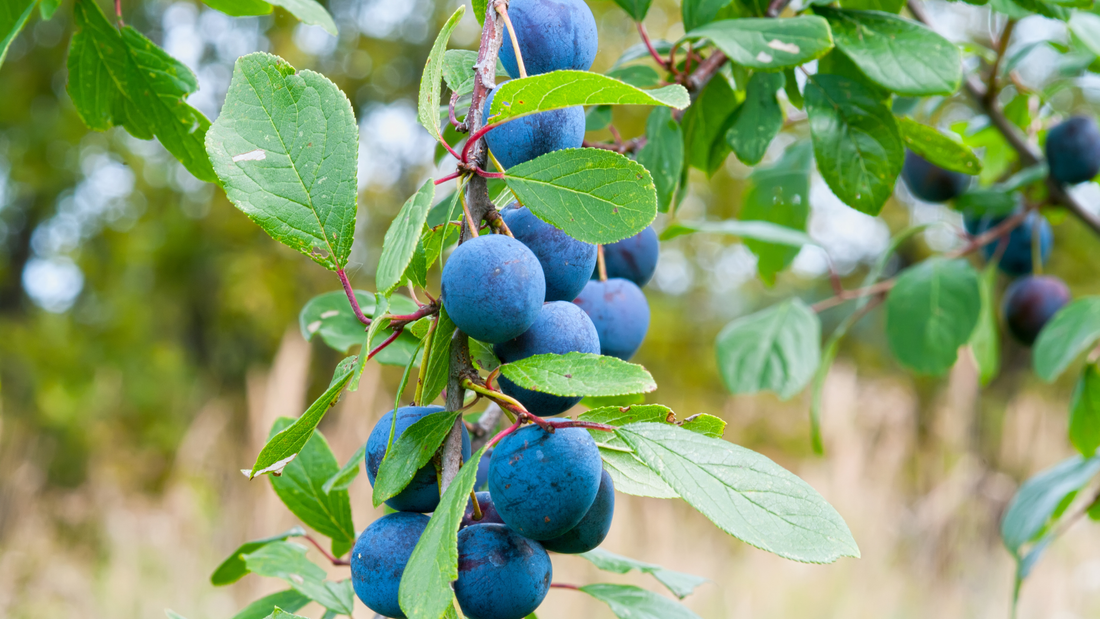Let's forage for sloes and use them to flavour our homemade Kombucha!
Foraging is one of the simplest and most rewarding ways to connect with nature, and in the UK we are blessed with a HUGE variety of wild plants.
Among the most distinctive of these are sloes, the small dark purple fruits that grow to cover the blackthorn bush.

While many people know sloes as the traditional flavouring for sloe gin, they are far more versatile than that.
One surprising and delicious way to use them is to infuse them into a homemade Kombucha, a tangy, probiotic-rich drink made from fermented tea.
This combination brings together the health benefits of sloes and Kombucha in a drink that’s refreshing, seasonal, and naturally crafted.
This guide will explain how to forage for sloes in the UK, how to make your own Kombucha, and how to infuse your Kombucha with sloes for a delicious homemade, natural & pink fizz, for special summer occasions.
If you're looking for the best way to get started making your own Kombucha at home, we're famous for our beginner friendly Kombucha Starter Kits, and if you've never tasted a homemade Kombucha, order a FREE sample of ours here.

Foraging for Sloes
Sloes grow on the blackthorn bush, Prunus spinosa, a spiky shrub that is common throughout the UK.
You can often find them along hedgerows, woodland edges, and field boundaries. The bushes flower in early spring with clouds of white blossom. The berries begin to develop through summer and are normally ready to pick in autumn.
The best time to pick sloes is from late September to November, but this can vary slightly year by year.
Traditionally, people wait until after the first frost, which helps soften the fruit and mellow its sharp flavour, however you can pick them earlier, and simply freeze them at home overnight for the same effect.
When foraging, always make sure you have permission to pick, especially if you are on private land. Take only what you need and avoid stripping a bush entirely. Take care when handling blackthorn; the branches have sharp spines that can prick the skin. A pair of gloves and long sleeves are a good idea!
Look for berries that are deep purple to almost black, with a slight bloom on the skin, similar to a grape. They should feel firm but not rock-hard when squeezed.
Avoid any that are shrivelled, mouldy, or damaged. Sloes are naturally sour and astringent when raw, but don't be put off as that tartness will mellow and blend beautifully during infusion.
Why Sloes Are Good for You
Sloes are rich in vitamin C, which supports the immune system and helps protect cells from damage caused by free radicals.
They also contain tannins, compounds that give the fruit its astringency, which are known for aiding digestion and supporting oral health.
The deep purple colour of sloes comes from anthocyanins, plant pigments that have anti-inflammatory and antioxidant effects. These compounds may help reduce inflammation in the body, promote heart health, and support brain function.
Drinking sloes in Kombucha means you get the benefits of both ingredients. Kombucha is naturally rich in probiotics, which support gut health by helping maintain a healthy balance of bacteria in the digestive system.
It also contains organic acids, such as acetic and gluconic acids, that may aid digestion and support liver health. Combining sloes and Kombucha creates a drink that is refreshing, tangy, and potentially beneficial for overall wellness.
Making Your Kombucha Base
Often referred to as the first fermentation, this is where sweet tea is mixed with a live culture, known as a SCOBY (Symbiotic Culture of Bacteria and Yeast).
We have a free guide on how to get started with your own Kombucha brew here.
Sloes are perfect to infuse with either a green tea Kombucha or a rooibos tea Kombucha (we have lots of different blends available in our range of Kombucha Brew Bags) if you're looking for a low or no caffeine blend.
When the flavour of your Kombucha is just right, it is time to remove it from the SCOBY, and move it into fermentation safe glass bottles. This is where the fun starts, i.e., the infusing!
If sloes aren't your thing, or you couldn't find any this year, we have loads more recipes here, on Our Kombucha Recipe Club.

How to Infuse Kombucha with Sloes
Once your first fermentation is complete, you can begin the second fermentation, which is when the sloes are added.
This is the stage that adds flavour into your Kombucha and, maybe, some carbonation.

Step-by-step sloe infusion:
- Prepare your sloes. Wash them thoroughly, then prick each berry several times with a clean needle or pin. This helps release their juice and colour. Make sure to freeze them if you picked them before the first frost.
- Use one small handful of sloes per litre of Kombucha.
- Option to add 1 teaspoon of sugar per litre. This will increase carbonation, so make sure to burp bottles and store safely. We recommend adding this sugar if your Kombucha is on the tart side after first fermentation, as sloes themselves have a tarty bite to them!
- Place the prepared sloes into clean glass bottles with flip-top lids (we have the perfect ones here).
- Pour your Kombucha over the sloes, leaving about 3 centimetres of headspace in each bottle, and add sugar if using.
- Seal the bottles and leave them at room temperature for 2 to 5 days. Taste daily after day 2. The longer it sits, the stronger the sloe flavour and the more carbonated it will become (especially if you added sugar).
- Once the flavour is to your liking, strain out the berries and put the Kombucha in the fridge. Chilling stops the fermentation.
- Serve cold and enjoy the beautiful deep pink colour of this natural health tonic.
Other Summer Kombucha Infusion Ideas with Sloes
- Sloe and Rosemary Sparkler: Add sloes with a sprig of rosemary to each bottle. Rosemary adds a piney note to balance the fruits. Infuse for 2-3 days then serve over ice with a slice of lemon
- Sloe, Mint and Lime Refresher: Add sloes, a few fresh mint leaves (torn) and a wedge of lime to each bottle. This makes a great cocktail base for summer. Infuse for 2 days, then remove the lime, and leave mint and sloes for 2-3 more days before serving chilled
- Sweet Sloe and Vanilla: Add sloes and half a vanilla pod (or 1/2 teaspoon vanilla extract) to each bottle with Kombucha. Option to add 1 teaspoon of sugar to boost carbonation (make sure to burp bottles). Infuse for 3-4 days, to create a rich, desert like drink - YUM
Tips and Troubleshooting
When making and infusing Kombucha, cleanliness is key. Make sure all utensils, jars, and bottles are clean to prevent unwanted mould or bacteria.
If you see mould on the surface of your brew (fuzzy and fluffy patches) you'll have to discard it entirely and start again with a clean jar and fresh ingredients.
If your Kombucha is too sour, shorten the first fermentation next time. If it is too sweet, extend the fermentation by a day or two.
We recommend using Kombucha which has been removed from first fermentation a little earlier than normal, just one day would do. This keeps a little extra sweetness in the Kombucha itself, to balance out the tartness of the sloes.
Carbonation depends on yeast activity during the second fermentation. Warmer rooms produce more fizz, while cooler temperatures slow it down.

If your Kombucha is flat, adding a small piece of dried fruit or a teaspoon of sugar along with the sloes during the second fermentation to feed the yeast.
Foraging combines exercise, fresh air, and delicious (free) ingredients, and you can create a drink that offers a variety of health benefits.
Whether you prefer the fresh notes of green tea Kombucha or the earthy richness of rooibos Kombucha, the tart sloes will transform your brew into something exciting.
The process is straightforward, and with a little care and patience, you can enjoy a naturally fermented, fizzy drink that celebrates the flavours of the British countryside.


